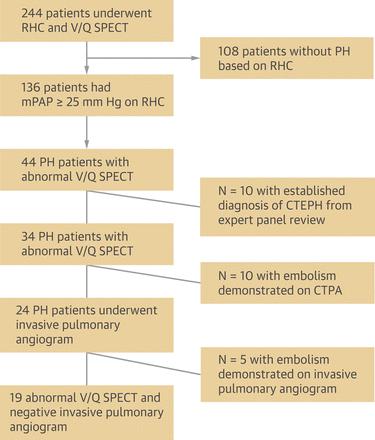JACC: Cardiovascular Imaging ( IF 14.0 ) Pub Date : 2018-10-01 , DOI: 10.1016/j.jcmg.2017.07.026 Kenneth Chan , Stefanos Ioannidis , John G. Coghlan , Margaret Hall , Benjamin E. Schreiber

|
Objectives This study aimed to evaluate the incidence and clinical outcomes of abnormal ventilation/perfusion (V/Q) single-photon emission computed tomography (SPECT) without thromboembolism, especially in patients with group I pulmonary arterial hypertension (PAH).
Background American Heart Association/American College of Cardiology and European Society of Cardiology guidelines recommend V/Q scan for screening for chronic thromboembolic pulmonary hypertension. The significance of patients with abnormal V/Q SPECT findings but no thromboembolism demonstrated in further investigations remained unclear. A distinct pattern of global patchy changes not typical of thromboembolism is recognized, but guidelines for reporting these in the context of PAH are lacking.
Methods A total of 136 patients who underwent V/Q SPECT and right-sided heart catheterization showing mean pulmonary arterial pressure ≥25 mm Hg were included. V/Q SPECT findings were reported using European Association of Nuclear Medicine criteria for pulmonary embolism followed by computed tomography pulmonary angiography screening for positive thromboembolism and further invasive pulmonary angiography for distal thromboembolism. The abnormal V/Q SPECT images were further analyzed according to perfusion pattern into focal or global perfusion defects.
Results V/Q SPECT showed thromboembolic disease in 44 patients, but 19 of these patients had no thromboembolism demonstrated by pulmonary angiography. Among these patients, 15 of 19 (78.9%) had group I PAH, and the majority had diffuse, patchy perfusion defects. After redefining V/Q SPECT images according to the perfusion pattern, those patients with global perfusion defects had higher mean pulmonary arterial pressure compared with patients with focal perfusion defects and normal scans (mean difference +13.9 and +6.2 mm Hg, respectively; p = 0.0002), as well as higher pulmonary vascular resistance (mean difference +316.6 and +226.3 absolute resistance units, respectively; p = 0.004). Among patients with PAH, global perfusion defects were associated with higher all-cause mortality with a hazard ratio of 5.63 (95% confidence interval: 1.11 to 28.5) compared with patients with focal or no perfusion abnormalities.
Conclusions There is a high incidence of abnormal V/Q SPECT scans in nonthromboembolic PAH. Further studies are needed to investigate the poor outcome associated with abnormal V/Q SPECT findings in the context of PAH.
中文翻译:

目的本研究旨在评估无血栓栓塞的异常通气/灌注(V / Q)单光子发射计算机断层扫描(SPECT)的发生率和临床结局,特别是在I组肺动脉高压(PAH)患者中。
背景美国心脏协会/美国心脏病学会和欧洲心脏病学会指南建议使用V / Q扫描筛查慢性血栓栓塞性肺动脉高压。V / Q SPECT异常发现但在进一步研究中未发现血栓栓塞的患者的意义仍不清楚。公认的血栓栓塞性发作的独特的全球性斑块变化模式,但缺乏在PAH背景下报告这些斑块的指导原则。
方法纳入136例行V / Q SPECT和右侧心脏导管检查的平均肺动脉压≥25 mm Hg的患者。使用欧洲核医学协会的肺栓塞标准报告了V / Q SPECT发现,随后通过计算机断层扫描肺血管造影筛查阳性血栓栓塞和进一步的侵入性肺血管造影检查远端血栓栓塞。根据灌注模式进一步分析异常的V / Q SPECT图像,分为局部或整体灌注缺陷。
结果V / Q SPECT在44例患者中显示出血栓栓塞性疾病,但其中19例患者的肺血管造影未显示血栓栓塞。在这些患者中,19名患者中有15名(78.9%)患有I组PAH,并且大多数患者存在弥漫性,斑片状的灌注缺陷。在根据灌注模式重新定义V / Q SPECT图像后,与局部灌注缺陷和扫描正常的患者相比,整体灌注缺陷的患者的平均肺动脉压更高(平均差分别为+13.9和+6.2 mm Hg; p = 0.0002),以及更高的肺血管阻力(平均差分别为+316.6和+226.3绝对阻力单位; p = 0.004)。在PAH患者中,整体灌注缺陷与更高的全因死亡率相关,危险比为5.63(95%置信区间:1.11至28)。
结论非血栓栓塞性PAH发生V / Q SPECT扫描异常的可能性很高。在PAH的背景下,需要进一步的研究来调查与异常V / Q SPECT发现相关的不良结果。



























 京公网安备 11010802027423号
京公网安备 11010802027423号